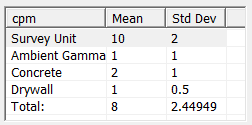

In this table, the activity means and standard deviations can be entered using the specified units. We will assume counts per minute (cpm) was chosen for this example.
The expected mean and standard deviation for the survey unit must be entered.
Additionally, if you choose to use background corrections, you must also enter estimated means and standard deviations for each of the background factors. In this example, Ambient Gamma and two material specific backgrounds (Concrete and Drywall) have been specified. Background correction factors can be specified by clicking on the button labeled Bkg Corrections.
If background factors are used, the total mean is calculated as the Survey Unit Mean minus the Ambient Gamma Mean and the smallest Material Specific Background Mean. In this example, the total mean is: 10 - 1 - 1 = 8 (cpm).
If background factors are used, the total standard deviation is calculated as the geometric mean of the Survey Unit Standard Deviation, the Ambient Gamma Standard Deviation and the largest Material Specific Standard Deviation:
\begin{equation} S_{tot} = \sqrt{(S_{su})^2+(S_{ag})^2 +(S_{mm})^2} \end{equation}
Where \(S_{su}\) is the Survey Unit Standard Deviation, \(S_{ag}\) is the Ambient Gamma Standard Deviation and \(S_{mm}\) is the maximum Material Specific Standard Deviation. In this example the total standard deviation is \(\sqrt{2*2 + 1*1 + 1*1 }\) = \(\sqrt{6}\) = 2.44949 (cpm).